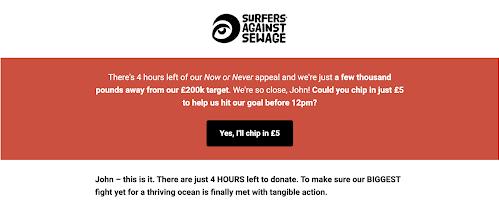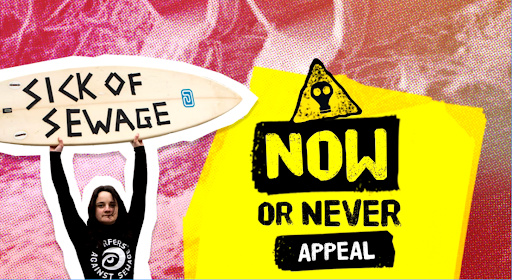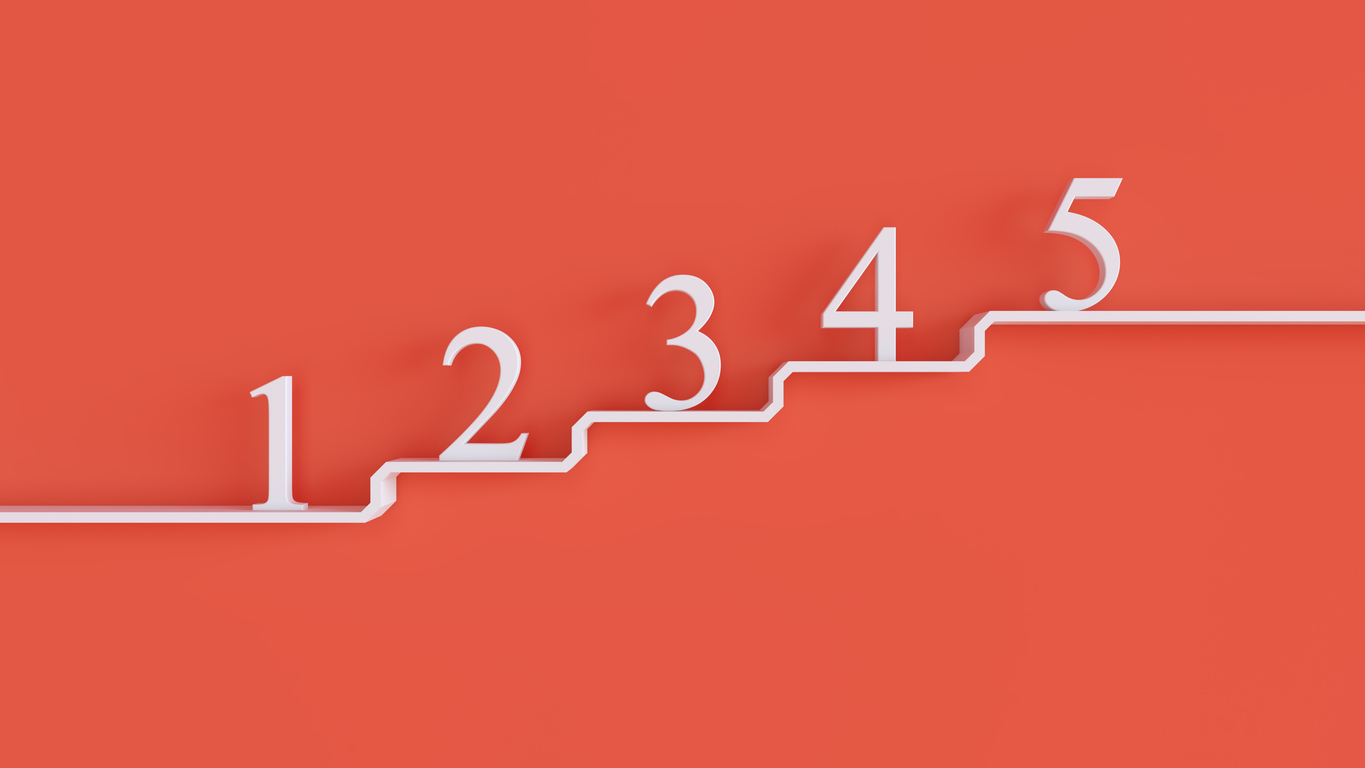This morning we hosted a webinar with our partners at Surfers Against Sewage to share our experiences of how we raised £204,000 in one week through our Now or Never Appeal.
If you’re planning your next fundraising appeal or gearing up for the big one this winter, here’s what you need to know about how we created a campaign that really stood out.
Here’s how we did it:
1: We Found Our Hook
Surfers Against Sewage had ambitious plans to raise £200k – their biggest fundraising target yet – in the April Big Give Green Match Fund. They didn’t have one clear service needing funds, so our challenge was to find the perfect hook – the big, attention-grabbing appeal ID that clearly communicated why people should help them meet their target.
Together, we ran a cross-team workshop to ask key questions to help find our hook (Why this – what’s the problem you’re solving? Why now – why is this urgent? Why me – why should a donor care? What for – where’s my money going?).
We learned that:
- Surfers Against Sewage had seen a recent groundswell of public support – and a rise in general outrage over sewage (Why now? Why me?).
- They had a community of supporters and groups working hard against water companies through protests and public campaigns (What for?).
- They had high hopes for an upcoming election, the chance to see some of their demands become real policy change – but they needed extra support to organise hustings, plan policies, and get noticed in parliament (Why this?).
This helped us come up with our hook, the “Now or Never Appeal” and give it a bold visual ID.
The “Now” encapsulated the big moment for Surfers Against Sewage. The “Never” showed the urgent need for donors to help provide extra resources ahead of an (as yet unannounced!) election. Without meeting the target, their calls for cleaner seas may get ignored, and years of hard-won progress could be lost.
2: We Built Our Story
The “Now or Never” proposition was a great start. Next, we needed to flesh out our story – to find our main characters, repeat our message, and decide how our appeal would be structured.
Since our campaign focused on email, we started with an email plan – looking at what the call to action would be for each and who would be the sender:

Just like any good story – we wanted to start and finish with a bang! Experience shows that people would most likely donate at the start and the end of the campaign. We launched with a direct message from Surfers Against Sewage’s founder, Chris Hines. His voice of authority showed that we meant business (though his fun, direct writing style made it more engaging than official!). And we culminated in a final push that emphasised the critical “Now or Never” moment – reminding people that they only had 24 hours left to donate. In the middle of the campaign, we mixed up the content, using a case study from a swimmer and a localised quiz on the worst water companies.
This structure was reflected in our plan for organic Facebook posts – starting with a message from the founder, mixing it up with more engaging content in the middle, and ending with a more direct and urgent 24-hours-to-go message.
3: We Tested Our Tactics
Surfers Against Sewage has a large, engaged list of 143,000 subscribers, making perfect grounds for testing. We also had useful learnings from testing tactics in their 2023 Big Give Campaign. From previous campaigns, we knew that:
- Adding designs to emails didn’t affect donation rates – so we kept designs simple, only including them where they helped visualise complex information.
- Sending one email per day didn’t affect unsubscribe rates – so we continued to send daily emails to make sure the appeal got as much attention as possible in the short timeframe we had to raise money.
This year, we trialled even more tactics to further nudge up our income:
- Sending an urgent reminder email when there were 24 hours until the end of the campaign was highly effective, with more than £30,000 raised on the final day.
- Adding call-out boxes to the top and bottom of our emails grabbed attention, with many donors selecting to chip in £5 in the final email of the campaign.

Being able to use our learnings from last year gave us fertile ground to test and trial new tactics that helped further nudge up funds to meet our target.
4. We Made Space to Be Reactive
Midway through the campaign, there was a shocking twist. Surfers Against Sewage received a donation and a message from an ex-Water Company boss in response to the appeal.
We knew this was a moment to respond quickly to – and thanks to speedy copywriting from Forward Action and a quick email build from Surfers Against Sewage, the former insider’s message had become a fundraising email that brought in 184 donations within just 12 hours:
Reactive emails are crucial for adding authenticity and timeliness to your campaign, keeping supporters engaged and informed. They allow you to showcase impact and momentum while boosting donations by responding to unexpected moments.

Conclusion
It was the blend of strategic moments and tactics, all anchored by a compelling “Now or Never” proposition, that helped us surpass our £200k target.
As expected, donations peaked at the start and end of the campaign, while every moment throughout kept engagement high and painted a vivid picture of Surfers Against Sewage’s mission. The key takeaway isn’t just to send a last-minute ’24 hours to go’ email. It’s crucial to identify your ‘why now’ and to create your compelling appeal identity, and then tell the beginning, middle, and end moments that bring your fundraising proposition to life – so that any supporter will be encouraged to dig deep in your next appeal.

Questions and answers…
There were so many questions this morning, so we thought it’d be useful to share the answers here -including some we didn’t have time to cover during the webinar.
Was there a multichannel approach? What channels were used?
Surfers Against Sewage used email and organic Facebook posts for their campaign. They have a highly engaged audience of 143,000 subscribers, built over years through petitions, paddle-out protests, and other tools. This strong base helped them reach their fundraising goals without needing paid social media.
Were there any plans for ‘warm-up’ emails ahead of the campaign?
Surfers Against Sewage chose not to send a ‘warm-up’ email because we already had an email each day planned. However, they might consider trying this in future campaigns. However, we would recommend that all emails you send have a call to action – so if you do plan a warm-up email, make sure that it’s a useful email for your supporters to receive.
Were unsubscribe rates affected?
Even though an email per day was sent through the campaign – unsubscribe rates stayed normal because of the limited time the campaign was run, and the urgent nature of the appeal. Surfers Against Sewage also warned supporters that there may be more emails than usual in their first email.
What email platform was used? How was success tracked?
Surfers Against Sewage used CreateSend for managing their email campaigns. This platform made segmentation, personalisation, and AB testing easy, which were all crucial for optimising the appeal’s performance.
Income tracking was carried out through the Big Give website, which has capability to show daily income. We assumed email to be the primary driver of donations since we saw income peaks after emails were sent.
How was the list personalised and segmented?
Emails included personalised greetings using first names, and specific messages were sent to previous Big Give donors and regular supporters. Surfers Against Sewage found that 90% of donors were repeat givers – so it was worth acknowledging their previous gift.
The campaign also used a basic segmentation such as locality-based targeting for the ‘worst water companies’ quiz. However, we kept segmentation to a minimum.
Was there any major donor engagement?
The major donor team was very important in the campaign. Surfers Against Sewage worked closely with key donors to get the most out of matched funding. By staying in touch, they made sure these donors knew about the campaign and were motivated to give.
What was their value exchange campaign?
The “Vote for the Ocean” initiative involved offering a free poster in exchange for contact details during the election period.
This campaign was supported by a telemarketing agency that followed up to convert these contacts into regular givers. The strategy proved effective, with ongoing requests for posters and new memberships continuing three weeks post-election.
How did you make a totaliser graphic?
A totaliser graphic was provided by the Big Give platform to display fundraising progress.
We also created a designed graphic to visually indicate the need for further donations, which served as a motivational tool for potential donors (this wasn’t accurate – it was just created to show that there was still a way to go until the target was met).


